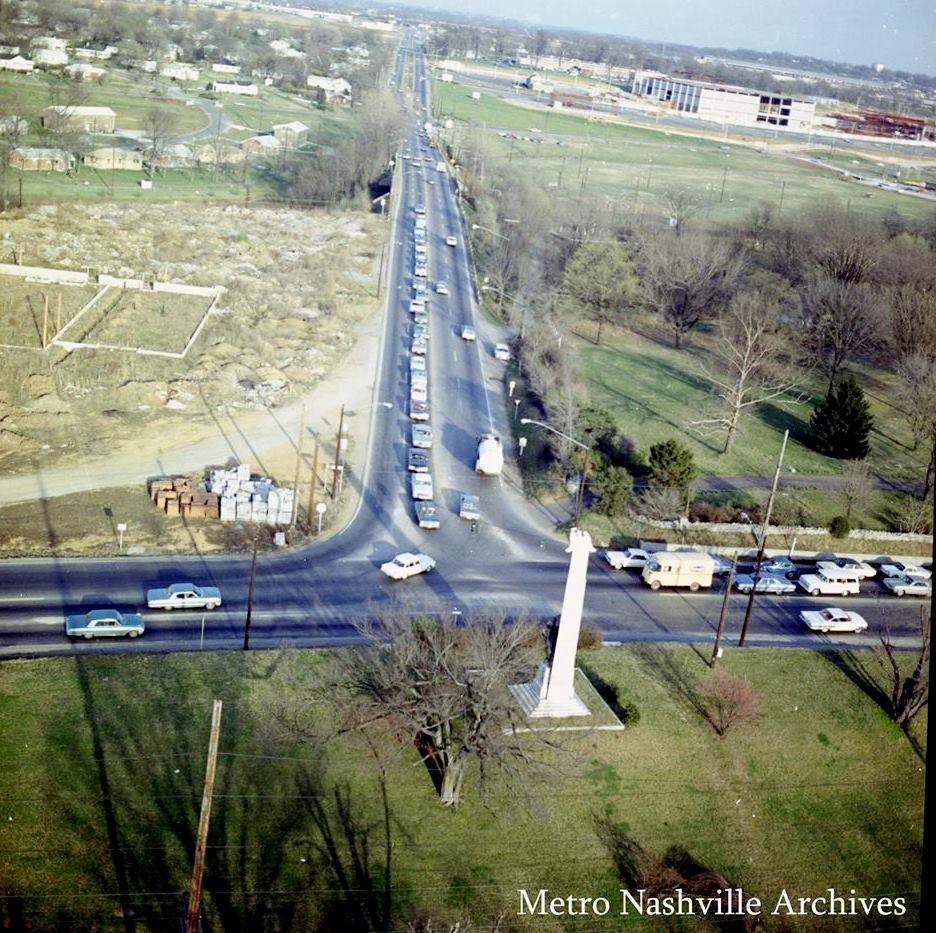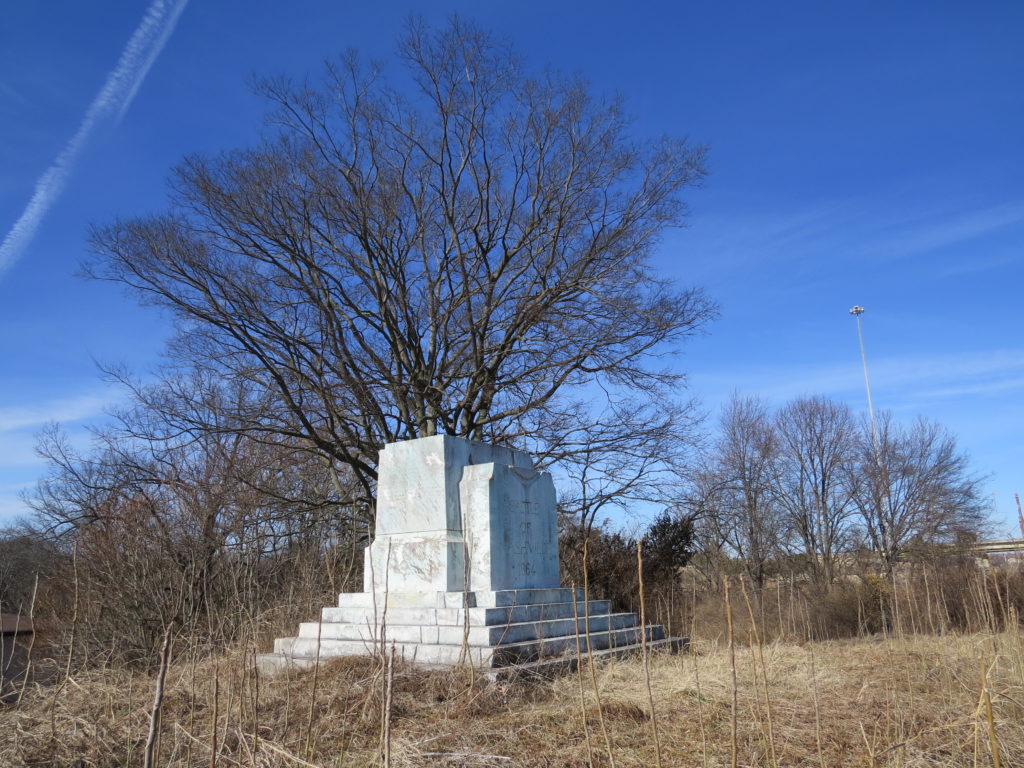 The Battle of Nashville Monument, often referred to as the “Peace Monument,” is a white granite and bronze monument which honors the sacrifices of both Confederate and Union soldiers who fought in the December 15-16,1864 Battle of Nashville, as well as the American soldiers who fought in the World War I (“The Great War”).
The Battle of Nashville Monument, often referred to as the “Peace Monument,” is a white granite and bronze monument which honors the sacrifices of both Confederate and Union soldiers who fought in the December 15-16,1864 Battle of Nashville, as well as the American soldiers who fought in the World War I (“The Great War”).
Owned by the Tennessee Historical Commission, the monument was commissioned by the Ladies’ Battlefield Association and sculpted by Giuseppe Moretti of Italy. It was originally located just off Franklin Pike on property donated by the Vaulx family heirs for a Battle of Nashville park, and had been dedicated on Armistice Day, 1927. That monument, with its 30-foot obelisk, was destroyed when toppled by a tornado in 1974. For more history and excellent photos of the original monument, see below.
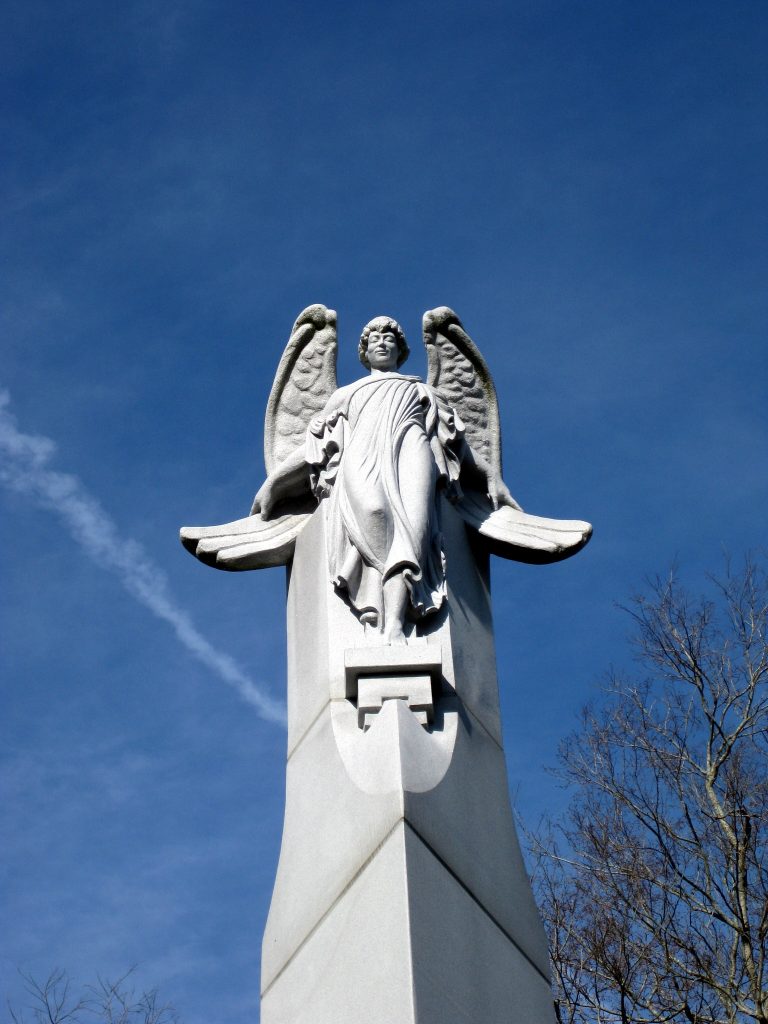 The Monument was re-built by Moretti and placed within a new Monument Park on battlefield ground located at the corner of Granny White Pike and Clifton Lane, and dedicated on June 26, 1999. The original location, though it was historically important in that it had been the location of an artillery battery in Lee’s Corps, lost its appeal after construction of a major interchange for Interstate 65 erased the view, both of and from, the original placement.
The Monument was re-built by Moretti and placed within a new Monument Park on battlefield ground located at the corner of Granny White Pike and Clifton Lane, and dedicated on June 26, 1999. The original location, though it was historically important in that it had been the location of an artillery battery in Lee’s Corps, lost its appeal after construction of a major interchange for Interstate 65 erased the view, both of and from, the original placement.
At the time of the Battle of Nashville, the land where the park now exists was part of the 1,500 acre Oscar Noel farm and was located virtually adjacent to the line of Stewart’s Corps arrayed along the right flank of the Confederate line. Federal troops, including those of Woods’ IV Corps, stormed over this ground on December 15, 1864, in their assault on Stewart’s line, including the men of Loring’s Division which also had responsibility for Redoubt No. 1, about a mile to the west.
A large “basket oak” tree which stood on the farm at the time of the battle remains to this day, and has been verified to be a “Witness Tree” by the Tennessee Landmark and Historic Tree Registry. See story below.
Sculptor Moretti was able to clean and re-set the bronze centerpiece of the monument following the tornado. In his design, two rearing steeds, which he said represented the North and the South, were yoked together by a young man symbolizing all Americans who fought in the Civil War and World War I. The word “UNITY” is inscribed on the banner with which he entwines the horses. The bronze sculpture was said to be fashioned out of melted cannon barrels. The soaring granite obelisk, topped by an angel overlooking the battlefield, had to be completely re-built.
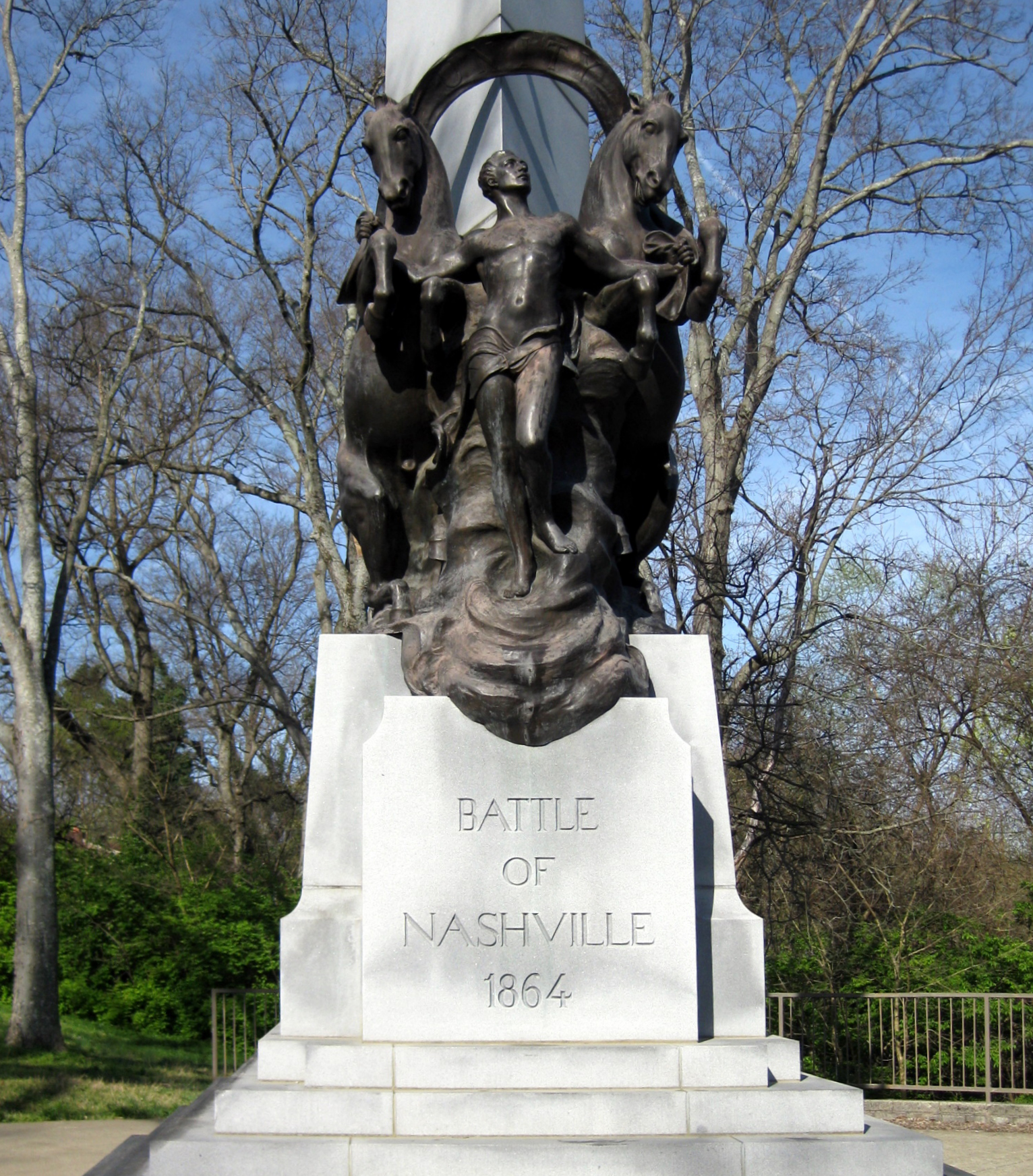
The engraved inscription on the South Face of the Monument explains the bronze figures as follows:
The Spirit Of Youth Holds In Check Contending
Forces That Struggled Here At The Fierce Battle Of
Nashville, Dec. 16th, 1864, Sealing Forever The
Bond Of Union By The Blood Of Our Heroic Dead Of The
World War 1917 – 1918.
A Monument Like This, Standing On Such Memories,
Having No Reference To Utilities, Becomes A Sentiment,
A Poet, A Prophet, An Orator To Every Passerby
On the North Face is a poem written by John Trotwood Moore, a journalist, writer, poet and local historian who served as the State Librarian and Archivist of Tennessee in the 1920s.
“Oh, Valorous Gray, In The Grave Of Your Fate,
Oh, Glorious Blue, In The Long Dead Years,
You Were Sown In Sorrow And Harrowed In Hate,
But Your Harvest Today Is A Nations Tears.
For The Message You Left Through The Land Has Sped
From The Lips Of God To The Heart Of Man:
Let The Past Be Past : Let The Dead Be Dead. —
Now And Forever American!”
Today, the base of the original monument still stands off Franklin Pike and marks the site of one of Stephen D. Lee’s batteries during the first day of the battle. See detail and photos below.
The Battle Line “Witness Tree” Still Holds Its Secrets
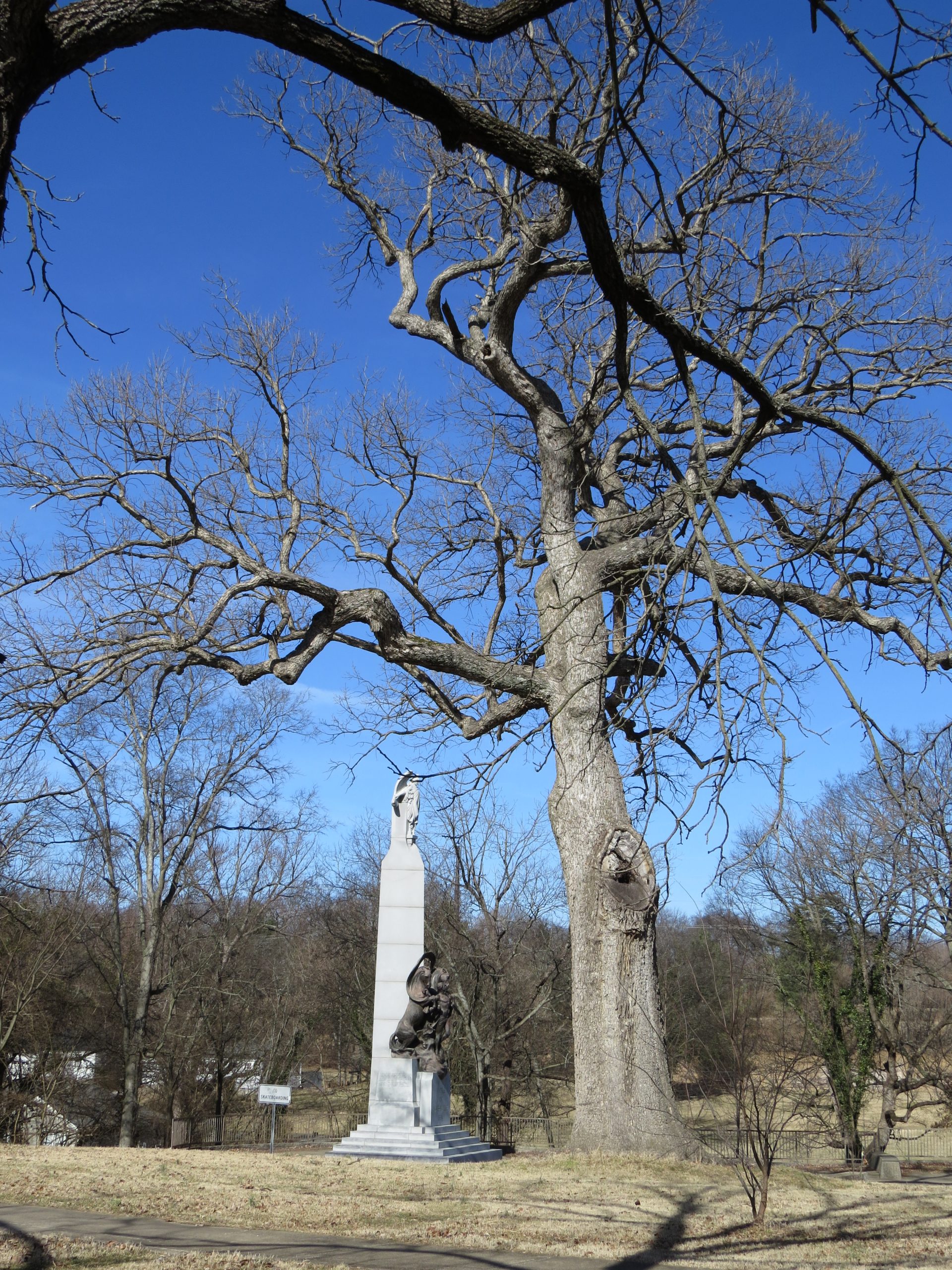
The Battle of Nashville Monument stands framed by a majestic “basket oak” tree (Quercus michauxii) which stood on this spot during the 1864 battle.
Records confirm that the tree was on the 1,500 acre farm of Oscar Fitzallen Noel and Sallie T. Noel. The farm was the site of violent fighting on the first day of the battle. The basket oak was located near the breastworks constructed by the Confederate line which ran diagonally across the property.
It has been designated a “Historic Tree” by the Tennessee Landmark and Historic Tree Registry, recognizing noteworthy trees for their significance to Tennessee. A “Historic Tree” must have been “a direct witness to a historic event or cultural movement that was significant nationally, regionally, or within the state and confirmed to date to that time.” For more information on this amazing tree, one of the last “living witnesses” to the Battle of Nashville, see: http://www.tufc.com/registries.html
June 26, 1999
BATTLE OF NASHVILLE MONUMENT REDEDICATED AT NEW PARK SITE
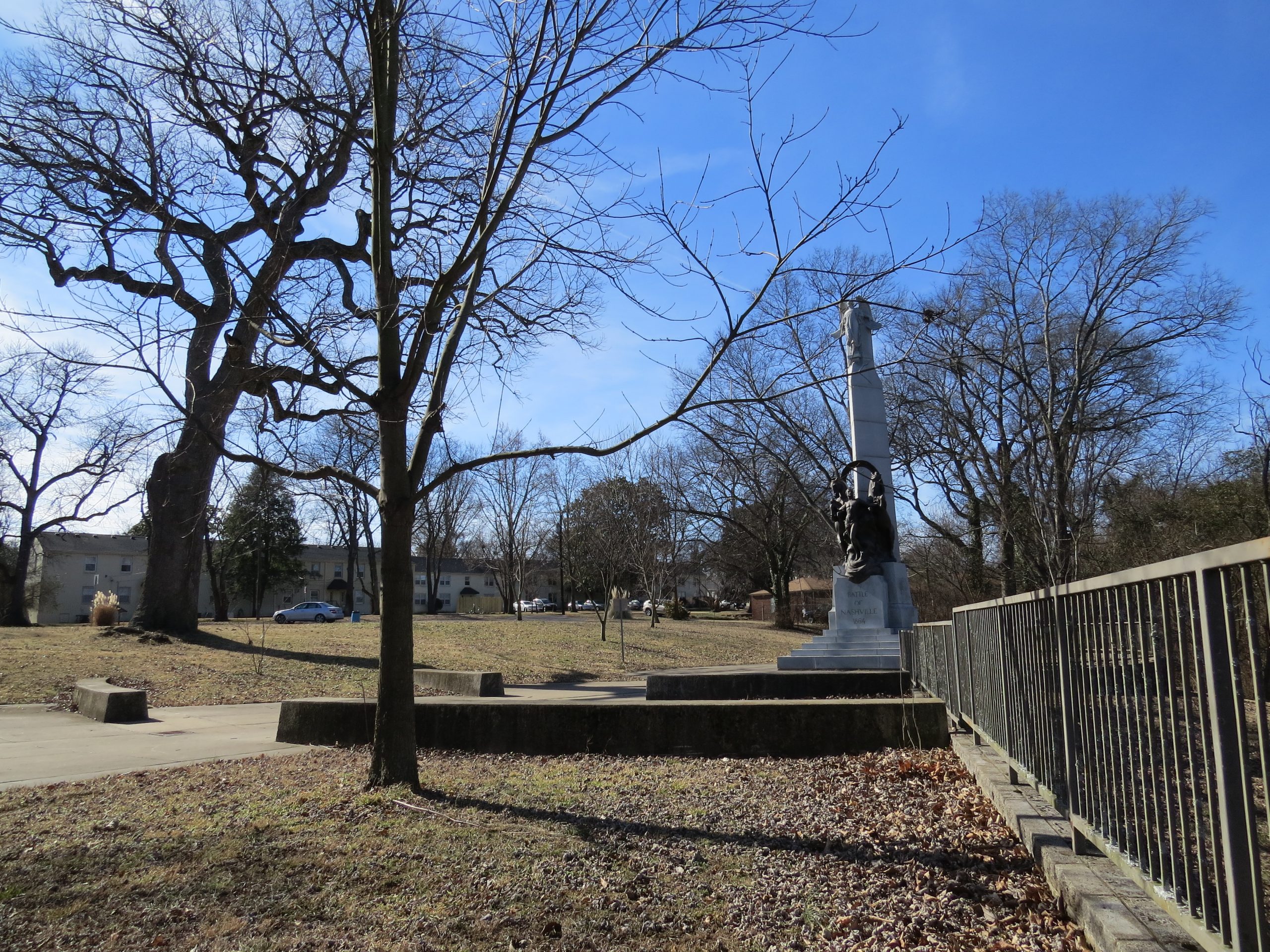
With several hundred spectators in attendance, the refurbished Battle of Nashville Monument was rededicated at its new location on Saturday, June 26, 1999, replacing the original marble obelisk destroyed by a tornado 25 years earlier and reinstating it to a place of honor virtually on top of the line of battle that occurred on December 15, 1864.
The principal speaker at the rededication ceremony was Mr. Wilbur Foster Creighton, Jr. of the Tennessee Historical Commission. Mr. Ward DeWitt, Jr., Chairman of the Commission, presided. During the ceremony, Civil War re-enactors presented the colors and a black powder salute, and the Graylyn Brass Quintet provided musical entertainment.
The new gleaming white granite monument honors not only the sacrifices of both Confederate and Union soldiers who clashed in the December 15-16, 1864 Battle of Nashville, but also the American soldiers who fought in “The Great War” (World War I). The original Monument had originally been dedicated on Armistice Day, 1927.
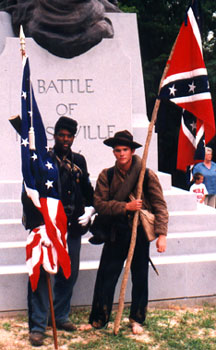 The re-dedication marked the successful completion of relocating the Nashville landmark from its original site on Franklin Road to the new park at Granny White Pike and Battlefield Drive.
The re-dedication marked the successful completion of relocating the Nashville landmark from its original site on Franklin Road to the new park at Granny White Pike and Battlefield Drive.
The Tennessee Historical Commission, which owns the statue, chose the new home for it in 1992. State and federal money, as well as generous private contributions, made the restoration possible. The monument was originally created in 1927 by artist and sculptor Giuseppe Moretti, who was commissioned by the Ladies Battlefield Association. In 1974, the obelisk and angel were destroyed by a tornado, and during the 1980s construction of a large interstate highway interchange had obstructed the monument to public viewing.
The new monument was completely restored, with the bronze sculpture of the youth and horses refinished, and the marble base, obelisk, and angel reconstructed in granite, which is more durable than the original marble.
During the re-dedication, several Nashvillians were singled out for their efforts in reestablishing the monument and the park grounds. They included James Summerville, local historian who spearheaded the project; Mrs. Paula McCord of McCord Crane Co., which donated its services to relocate the monument; Coley Coleman, the sculptor of the angel; Gary Hawkins of Hawkins Partners, Inc., the park designers; McPherson Shaw, Inc., the contractors; and Rehorn & Kelly.
After the ceremony, the Battle of Nashville Preservation Society sponsored a free concert at the north border of the park. Headlining the concert was RCA Records’ artist Andy Griggs, whose debut album, “You Won’t Ever Be Lonely,” had produced the #1 hit with the title-track single that year, and the album made its debut at an impressive #15 on the country charts the very first week of its release.
The concert also featured Greg Crowe (co-writer of the then-current Montgomery Gentry single, “Lonely and Gone”); Kimberly Dahne; multi-award winning singer / songwriter / playwright ; Chris Gantry; Tim and Trent LeClaire (Gantry, Tim, and Trent co-wrote the song “Garden of Angels” for this event); and Kevin Sysyn, who wrote the song “Nashville, 1864” with Charlie Baker for the occasion. Dr. Stewart Shofner, Cracker Barrel Old Country Store, and WKDF 103.3 sponsored the concert. Net proceeds from all donations received at the event were dedicated to battlefield preservation. Volunteers from Tennessee State Guard units in Nashville and Gallatin provided parking assistance and security during the day’s events.
A second phase of the monument project later resulted in the installation of walkways, benches, and interpretive elements at the park.
June 26, 1999
Battle of Nashville Monument Dedication Speakers
Comments by Gov. Don Sundquist
Cannon fire boomed across Nashville, and bullets whistled through the trees in one of the decisive battles of the Civil War, fought here on December 15-16, 1864.
Today, a long drive led by volunteers is crowned with success as we rededicate one of the finest war memorials in the United States, the Battle of Nashville Monument.
It is one of the few Civil War statues that honors the memory of both the Union and Confederate dead. The bronze figure of the young man also stands for Americans from north and south who fought again, now under a common flag of a reunited nation, in the Spanish-American War and in the first World War.
The Monument’s original builders understood and interpreted it for their time, and we may do the same for ours. Perhaps its meaning today is that what we have in common as Americans is more important than what divides us into bitterness over issues of race or class or ethnicity or gender.
I congratulate the Tennessee Historical Commission on this occasion, and thank it for restoring this grand old sculpture for the instruction and enjoyment of all our people.
With warm regards,
Don Sundquist
Comments by Wilbur Foster Creighton, Jr., Nashville Historical Commission
We come today to this hallowed place on the Battlefield where the first days fighting took place in the Battle of Nashville. We come to rededicate this most unique Civil War Monument which honors those who fought here from the North and from the South. All credit for the conception of the idea for the Peace Movement should go to Mrs. James E. Caldwell who lived on the Franklin Road at Caldwell Lane. Mrs. Caldwell had obtained a strip of land near her home on the Franklin Road that was an ideal place for a monument.
In 1910, the Board of Trade of Nashville appointed a committee to make a map of the Battlefield of Nashville and to place markers at all the important points. This committee then organized the National Battlefield Association. They went to Washington to lay the matter before Congress and to request a National appropriation for the marking of this battlefield.
Two gentlemen who had been in Nashville with the Federal army assisted the group in obtaining funds for the markers. Not long after this meeting in Washington, Mr. and Mrs. James E. Caldwell held a memorable meeting at their home, “Longview”. They called together this Battlefield Committee and their friends, a most unusual body of men. They honored and respected each other, though at the Battle of Nashville, they had fought desperately on opposite sides. Some of those present on that occasion were Governor James D. Porter, C.S.A., S.A. Cunningham, C.S.A., Major A.W. Willis, U.S.A., A.H. Robinson, U.S.A. and Major Wilbur Foster, C.S.A. Major Foster had been the head of General Stewart’s Engineer Corps and was appointed to make the map for the Association. Also present were Captain John W. Morton, C.S.A., and General Gates P. Thruston U.S.A., who was General George H. Thomas’s Judge Advocate General when he was the commanding officer of the Occupation Force in Nashville. General Thruston was later President of the Tennessee Historical Society. This group put the markers in place.
Mrs. Caldwell saw a wonderful opportunity for a monument commemorating the bravery and devotion of both sides in that conflict and honoring members of our armed forces. She called her friends and organized the Ladies Battlefield Association. Mrs. Caldwell contacted Giuseppe Morretti, a famous sculptor of San Reno, Italy who also had a studio in New York. She asked him to come to Nashville, look over their proposed site and advise her on the production of a Peace Monument, which would recognize the valor of both sides who fought in the Battle of Nashville. Mr. Moretti was pleased with the site and after returning to his studio in New York, he made a small model of the statue for Mrs. Caldwell for her approval. He gave her a cost estimate for a thirty-foot Peace Monument erected on her site. The cost of the monument seemed to be beyond the ability of the Ladies Battlefield Association but they immediately started raising funds.
Our entrance into World War I seriously delayed the fundraising efforts and Mrs. Caldwell was devastated when one of her sons died at one of the Army Camps during the War. After the war, the U.D.C. and other organizations aided in the fundraising efforts and sufficient funds for the monument were obtained.
In 1927, The Peace Monument was erected. Colonel Luke Lea, the commanding officer of the 114 Field Artillery in World War I, made the dedicatory address.
The Monument is a thirty-foot high shaft with an Angel of Peace gazing down upon the figure of a youth whose restraining hands hold the two fiery horses. The youth typifies the young manhood of the Nation who in the War brought about Unity between North and the South. Mr. Moretti claimed that this monument was his masterpiece. This is the only Civil War monument in the United States which honors the soldiers from the North as well as those from the South. During the construction of the highway near the Monument boards were placed around the Monument to protect it from the blasting. This was a mistake because in 1974 a tornado blew the monument down along with the protective boards. The bronze figures were repairable but the shaft and the angel were completely destroyed. We now have here an exact replica of the original monument.
After Ward DeWitt asked me to take part in this program, I consulted my family records to see what my family connection was with the Civil War. I remember the many stories Major Wilbur Foster, my grandfather’s partner in the construction business, told me, as well as stories told to me by my grandparents and great grandparents. One particular story was about my great grandfather Christopher Dudley who had an unusual experience during the war. He lived near Shelbyville, Tennessee. Two of his sons were in the Confederate Army and they came home when their units were operating near their home. Christopher Dudley was arrested by a group of Union soldiers who charged him with “aiding the enemy”. They were preparing to hang him when he said, “all I did was feed my boys when they came home”. He then gave the Masonic sign of distress. The Union officer in charge said, ”let him go, he is one of us”. Both of his sons survived the war and the oldest, Richard Houston Dudley, was elected Mayor of Nashville.
In 1927, at the dedication of the original Monument, only sixty-two years had passed since hostilities had ended in the Civil War. In the audience were many people who had suffered during the war. Some had lost members of their family; others had lost property and suffered during the “Carpet Bag Rule” in the South. Although it was suppressed, there must have been a great deal of animosity and hard feelings felt by the older people who were present on that occasion.
Now all of these people are gone. We can wipe the slate clean and celebrate this as truly a MONUMENT OF PEACE.
Recreating the Battle of Nashville Monument
Concept Plan for Interpretive Park
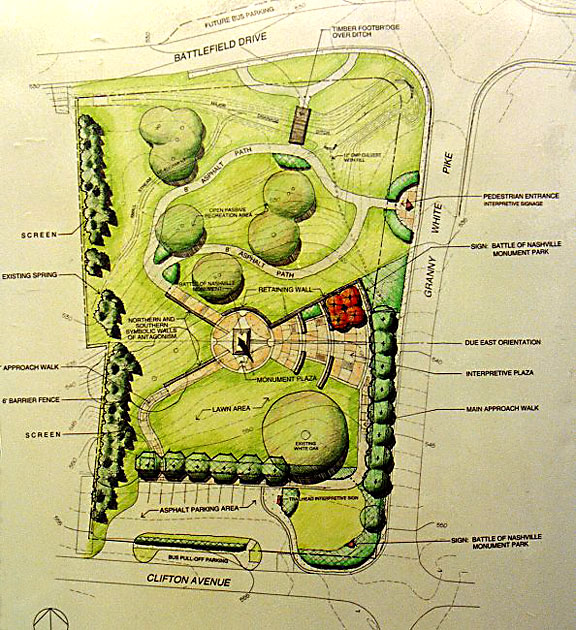
The park is a two-acre site just south of I-440 and bounded by Granny White Pike, Clifton Avenue, and Battlefield Drive. It sits on the battlefield at the northernmost penetration by Confederate forces. The plot forms the crest of a hill and is dominated by a large basket oak tree.
The monument was situated at the highest elevation, facing east as intended by original sculptor Giuseppe Moretti. Onsite parking and pathways enable visitors to view the monument close up, as well as view interpretive signage and a Wall of Peace, built with $72,000 in funds provided by the Frist Foundation.
Of the $225,000 raised for the project, all but about $15,000 was needed for the relocation and restoration of the monument itself. It was originally estimated that $400,000 would be needed to complete the park to the Concept Plan specifications.
Sculptor Coley Coleman noted that the new angel atop the monument’s obelisk is made of granite from Elberton, Georgia, which is much more suitable for outdoor sculptures than the monument’s original Italian marble. (The original obelisk and angel were destroyed during a 1974 tornado). He noted that he had to wait eight months to receive the granite from the quarry. The original bronze sculpture of a youth and two horses was cleaned and resealed at Rehorn & Kelly on Lebanon Road after being removed from the original site by McCord Crane Co. The bronze, which had turned dark with age and exposure, was restored to a beautiful light-brown bronze patina.
The original base remains at the old site on Franklin Road, said Commission chairman Ward DeWitt, who noted that the property should be maintained as a historical site. The small plot of land, now overshadowed by a huge interstate interchange (I-65 at I-440), will revert back to the heirs of the original donors otherwise. Confederate artillery was situated at that site during the battle.
November 6, 1998
History of the Battle of Nashville Monument
Presented by Ward DeWitt, Chairman of the Tennessee Historical Commission, at the Battle of Nashville Monument Symposium, Nov. 6, 1998.
The Battle of Nashville Monument has a long and sometimes tortuous history — a history not always smooth and pleasant — which perhaps is befitting a monument erected following and as a result of a bitter intersectional war. It needs to be remembered, however, that it is more than a monument to the battle which was fought here in December of 1864 — a battle which noted Nashville historian Stanley Horn called the Decisive Battle of Nashville. It is a monument which was conceived, built, and dedicated as a memorial to those brave men and women, from both North and South, who fought so courageously in not only the War Between the States but also in World War I, known as the Great War. It is a monument intended to unify the country, which in the early part of this century and even up until World War I was still badly torn with strife resulting from the Civil War.
The history of this beautiful monument goes all the way back to the year 1902, when the Vaulx heirs gave a tract of land on the Franklin Pike for a Battle of Nashville park. Mrs. James E. Caldwell, president of a group called the Ladies Battlefield Association, came up with the idea of a monument on the site, and a noted Italian sculptor, Giuseppe Moretti, submitted a quotation of $30,000 for it.
Then, about 1910, a Nashville battlefield park was again proposed, this time by Congressman Joe Byrnes of Nashville, and later that year a Congressional committee heard testimony from a group called the Nashville National Battlefield Association, comprised of prominent businessmen, including Confederate and Union veterans.
In April 1914 Mrs. Caldwell’s Ladies Battlefield Association held a “Historical Ball” at the Maxwell House to raise money for the monument, with the United Daughters of the Confederacy contributing generously.
In 1924 and early 1925 the Ladies Battlefield Association sponsored various fundraising events for the monument but only a small amount of money was raised. But by canvassing businesses and individuals and by appropriations from the Tennessee General Assembly and the Davidson County Quarterly Court, a lot more was raised toward the project.
The Monument was isolated by the construction of a huge interstate highway interchange.
In April of 1926 the L.B.A. contracted with Signor Moretti for construction of the monument on Franklin Pike where Thompson Lane intersected. In 1926 Moretti’s plaster model of the bronze figures was sent to the foundry to be cast, and quarrying of the marble was underway at Carrara in Italy. The bronze came from broken and melted cannons.
During 1927 Moretti came to Nashville and personally oversaw the construction of the monument, and on Armistice Day, 1927 (November 11) it was dedicated, with former U.S. Senator and war hero Luke Lea giving the principal address. Unfortunately Moretti could not be here for the dedication, although he called the monument his greatest work.
In 1945 the acreage and monument were conveyed to the Tennessee Historical Commission by a successor group to the L.B.A., and there the monument stood in all its glory until 1974 — in full view of motorists on Franklin Pike or on Thompson Lane at its intersection with Franklin Pike. But then, on March 31, 1974, a tornado ripped through the area and toppled the 40-foot obelisk and angel atop it to the ground, shattering them into pieces. The bronze figures — two horses and a youthful man — were damaged but could be repaired and put back on the original base, but the obelisk and angel were not restorable.
Then, to add insult to injury, in early 1980 interstate construction virtually blotted out all view of the monument, which was, and still is, isolated behind a chain-link fence on a bluff overlooking Franklin Pike. It was a disaster.
At that point, following the tornado and interstate construction, some funds were allocated by the Department of Transportation for relocation but not restoration of the monument.
So, beginning in the 1980s the idea of a new location for and restoration of the monument was brought up, and the T.H.C. appointed a committee of citizens to suggest new sites. In 1988 the committee recommended Centennial Park, but the Metro Parks Board vetoed that and the committee was discharged. A number of other sites were considered, among them Riverfront Park, a grassy slope on the Burton Hills property on Hillsboro Pike in Green Hills, and the Brightwood Avenue bridge over I-440. None was accepted.
Finally, in 1992, the T.H.C., on the recommendation of its Markers and Monuments Committee chaired by Pam Garrett of Goodlettsville, chose the 2.5-acre tract at the intersection of Granny White Pike and Battlefield Drive which was originally slated to be an I-440 interchange. At this point the long struggle began for funds to remove and restore the monument to this new location.
Hawkins Partners, headed by Gary Hawkins, presented a plan for development of the site into an interpretive park, the T.H.C. applied for funds available under an act of Congress known as ISTEA, an acronym for Intermodal Surface Transportation Efficiency Act, and in 1995 a grant of $150,000 was given under that act. Soon thereafter, as a result of efforts by the T.H.C., $37,500 was given by both the State of Tennessee and Metropolitan Government of Nashville and Davidson County.
In 1996 the Nashville Iowa Club, spearheaded by Jon Ohrt and Jim Summerville, had a successful fundraising campaign which brought in $15,000, and bit by bit sufficient money came in to restore the monument to its former grandeur and move it to G.W. Pike and Battlefield Drive — right on the battlefield. But then, in August of 1996, the state architect’s office proposed that it be re-located to Tennessee’s new Bi-Centennial Mall in North Nashville. However, editorials in the papers, op-ed articles, the Metro Council and Governor Sundquist all endorsed the G.W. Pike site. The state Building Commission then endorsed the spending of the total budget, $225,000, for relocation and restoration at the G.W. Pike site.
In September of 1996 Hawkins Partners was hired by the state as chief contractor for the project, and last December the T.H.C. held a groundbreaking ceremony at the new site, at which 75 to 100 persons attended, including re-enactors and two of Mrs. Caldwell’s descendants. At this ceremony it was announced that the Frist Foundation had granted $65,000, later increased to $72,000, to build a Wall of Peace on the site.
Site preparation began last February; the foundation was poured Feb. 24, 1998. During this past summer work began on the carving of the angel of peace, and the first granite for the base arrived from the quarry in Georgia. In July the bronze was taken to Rehorn & Kelly, monument builders in Nashville, for cleaning. Tomorrow (Nov. 7, 1998) was scheduled to be Re-Dedication Day, but due to unexpected construction delays we decided to postpone that until restoration is complete. We will probably have the ceremony in early spring, but if you want to drive by the site and take a look at what has been done, I think you will find it interesting and agree that the site is a good choice.
Lastly, it is tempting to rattle off a long list of names of people who have been instrumental in bringing this project to near fulfillment, but if I started that then surely I would omit one or more who should be recognized, so I won’t do it. I do feel, however, that one person deserves special credit for his unflagging efforts to see this thing through to a successful conclusion, and that person is Jim Summerville, who put this symposium together. Jim, we thank you, and I thank you too.
April, 2020
DISCOVERED: RARE SCRAPBOOK CONTAINING PHOTOS AND MEMORIES OF THE 1927 DEDICATION OF THE BATTLE OF NASHVILLE PEACE MONUMENT
John Banks, noted Civil War author and blogger and member of the Battle of Nashville Trust board, has done some creative sleuthing and uncovered a treasure trove of history – in words and photos – of the original dedication of the Battle of Nashville Peace Monument in 1927.
Click on John Banks’ Civil War Blog to see what he unearthed in the Tennessee State Library and Archives – a scrapbook, put together by Mrs. May Winston Caldwell, memorializing the original Monument and its dedication on what was then Franklin Road near its intersection with Thompson Lane (an intersection which actually no longer exists, due to its linkage decades later with Woodmont Blvd. which now crosses over Franklin Road by bridge).
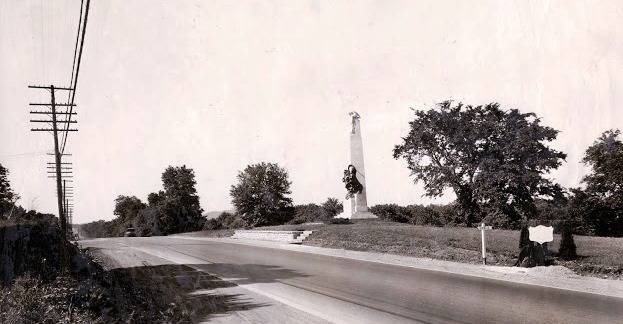
Above, one of the historically-important photos of the original BON Monument, discovered by John Banks in the scrapbook of Mrs. May Caldwell. In this cropped view, the photographer is standing along Franklin Road, looking south, near its then-intersection of Thompson Lane. If this photo were taken today, the photographer would almost be standing under the exit ramp from I-440 onto I-65 South.
The scrapbook and its recorded words and images provide a seldom-seen glimpse of the history and origins of the Monument, as well as the landscape around it as it appeared in 1927.
Below is a photographic comparison created by John Banks, showing images of the Monument taken in 1927 and from the same angle in 2020
Aerial View: Original Battle Monument Before Its 1974 Destruction By Tornado
The photo above shows the original Battle of Nashville Monument, erected overlooking Franklin Road and facing East along Thompson Lane. This photo was made in 1965. A tornado destroyed all but the pedestal of the monument in 1974, and its view was further obliterated by construction of I-65 and the I-440 interchange in the early 1980s. The direction of Thompson Lane was also moved from this pathway and curved in order to connect with Woodmont Blvd. In 1999, the monument was relocated and rededicated to a location on land that was once the Noel farm and was on the front line of battle on December 15, 1864, near the intersection of what is now Granny White Pike and I-440. The photo is from the Metro Nashville Archives. For close-up views of the remains of the original monument, see below.
The Ruins of the Original Battle of Nashville Monument: A Photo Gallery
The original location of the Battle of Nashville Monument is on a rise on Franklin Pike, near the intersection of Franklin Road and Woodmont Blvd, and close to the I-440 southbound exit ramp from I-65 South. It marks the right end of the middle of the Confederate line held by Gen. Stephen D. Lee on Dec. 15, 1864. Nothing remains except the original marble base of the monument which was heavily damaged by a 1974 tornado, requiring it to be rebuilt at the Granny White location.
To visit the site, go to the entrance to the Villa Adrian Apartments at 2964 Franklin Pike, and after turning into the main drive, take an immediate right onto a paved drive between the apartment parking lot and Franklin Pike. The monument base is located at the end of the paved drive, which is on government property owned by the Tennessee Historical Commission.
To take a brief video tour of the Monument’s history on both its original and current sites, click the link below which was created in 2022 by Chris Smith of Nashville:
